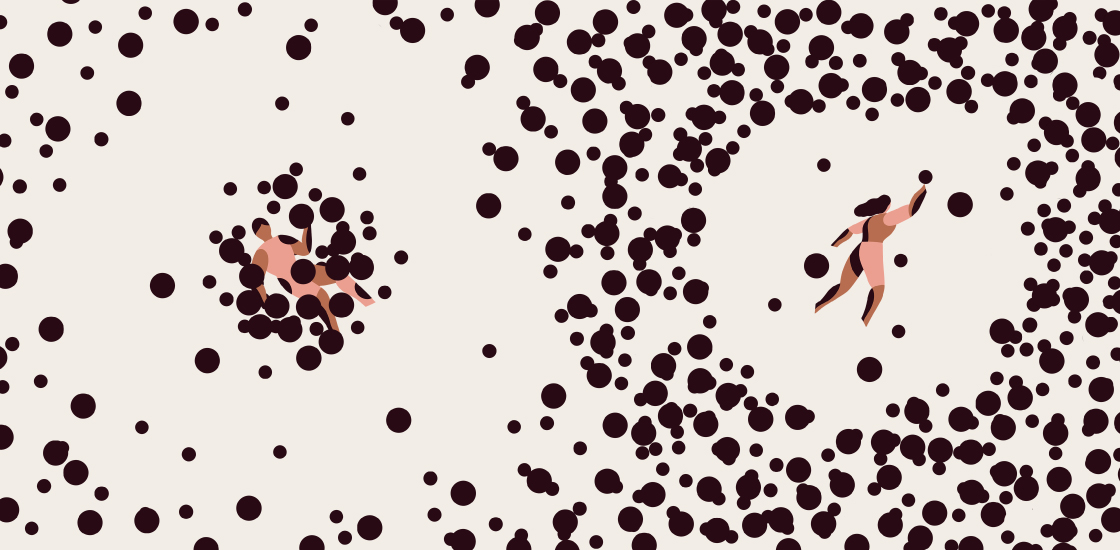Females are resistant to the influences of common, inherited genetic variants linked to autism, a new family study suggests. The findings lend support to the ‘female protective effect,’ a popular theory that proposes that people with two X chromosomes are somehow shielded from the condition.
Three to four times more boys are diagnosed with autism than girls. Autism is challenging to diagnose in girls and women, but genetics also plays a role in this skewed ratio: Autistic girls and women carry more rare, de novo variants linked to the condition — such as large disruptions in the genome and small insertions or deletions — than boys and men do, previous studies show.
The new work focuses on sex differences among common, inherited variants tied to the condition because “this was more of an area of ambiguity,” says Elise Robinson, assistant professor of epidemiology at Harvard University, who led the new research. Part of the problem, Robinson says, has been that sex differences in autism’s presentation and genetic architecture make comparisons of common variants challenging, yielding inconsistent findings.
Robinson and her colleagues used several different strategies to account for some of these differences. They assessed people with intellectual disability (ID) separately from those with autism because ID is more common in autistic females than males, which may skew results. The team also investigated the genetic load of common variants tied to autism in children with the condition as well as in their unaffected parents. Assessing parents enabled the team to get around issues related to diagnostic bias, Robinson says.
Siblings of females with autism alone are more likely to have autism than are siblings of males with the condition, the researchers found. Mothers of people with autism also carry a higher genetic load than fathers do, the team reported in June in Cell Genomics.
The findings provide “strong support for the female protective effect model” and may further motivate researchers to understand the mechanisms that underlie it, says Donna Werling, assistant professor of genetics at the University of Wisconsin-Madison, who was not involved in the research. “If we understand those mechanisms, then we have potential to better understand the biology of autism,” she says.
T
he new work drew on data for 1,707 siblings of autistic females without ID and 6,270 siblings of autistic males without ID from iPSYCH, a collection of medical and genetic information from more than 1.47 million people born in Denmark.Siblings of autistic females are seven times as likely to have an autism diagnosis as age- and sex-matched people from the general population in Denmark, whereas siblings of males are four times as likely, the researchers found. Given that siblings share a large proportion of their genetics, the findings suggest that females carry more autism-linked variants than males do. Siblings of people with ID alone, in contrast, are more likely to be diagnosed with ID than are people in the general population, but the likelihood does not differ by sex.
In another analysis, Robinson and her colleagues examined polygenic risk scores — sums of common variants tied to autism — for 7,628 people with the condition, 13,362 of their unaffected parents and 18,862 people from the general population. The data came from the Simons Simplex Collection, SPARK and the UK Biobank. (The Simons Simplex Collection and SPARK are funded by the Simons Foundation, Spectrum’s parent organization.)
Polygenic risk scores do not differ by sex in the general population, but mothers of children with autism have significantly higher scores than fathers do, the analysis shows. The extent to which unaffected children inherit autism-linked common genetic variants from their parents may also differ by sex, according to preliminary evidence: 1,611 unaffected female siblings’ polygenic risk scores are roughly the average of their parents’ scores, as expected by chance, but 1,519 unaffected male siblings’ scores are lower than the parental average, suggesting that they inherit fewer of the variants than expected.
“People have been looking for the female protective effect for a long time and mostly not finding it, but it looks like they got it in terms of higher thresholds for females in both mothers and siblings of females,” says Catherine Lord, distinguished professor of psychiatry and education at the University of California in Los Angeles, who was not involved in the study.
L
evels of polygenic transmission vary according to sex among people with autism too, the team also found. But the presence of disruptive de novo mutations modifies the genetic load filled by common, inherited variants. Generally, autistic children over-inherit common variants tied to the condition from their parents. Females without de novo mutations in autism-linked genes have nearly three times the levels of over-inheritance than males with de novo mutations, the new study shows.“It’s consistent with there being a convergence of sex, rare variants and polygenic risk all at once,” says Jonathan Sebat, professor of psychiatry and cellular and molecular medicine at the University of California, San Diego, who was not involved in the work but has previously collaborated with Robinson. In a study published earlier this month, Sebat and his team similarly found that females carry a greater polygenic and rare variant load than males do.
A lingering question in the field is the extent to which diagnostic bias or genetics account for autism’s sex ratio. “We haven’t answered that question yet,” Sebat says, but research is beginning to point in the direction of genes having different effects in males and females.
Robinson and her colleagues point out in the new study that their findings do not provide insight into mechanisms: Females may be protected from autism or males may be sensitive to it — or both. Also, genetic influences tied to autism are linked to other attributes in the general population, such as higher educational attainment and reasoning ability. Understanding the balance between factors that provide benefits and those that increase the likelihood of having difficulties is important not only in autism but across human variability, she says.






